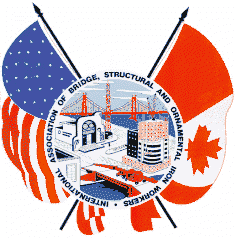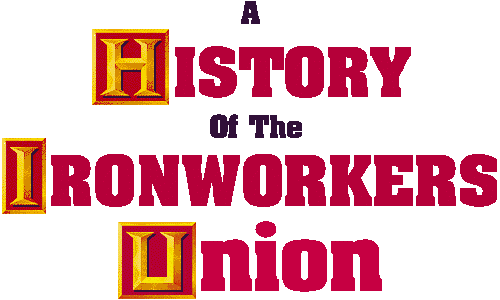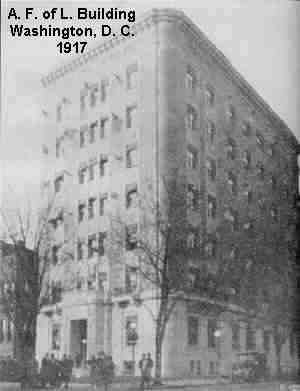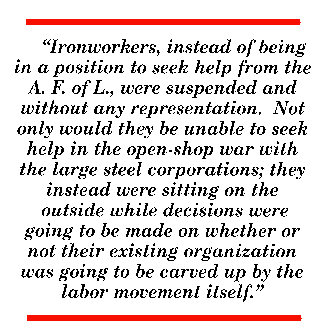|
|
|
|||
|
Our History
A Union is Born
The Turbulent Years
The Conspiracy Trials
The Beginning of the
Morrin Era
The Depression and a New
Deal For Labor
World War II
Ironworkers Grow in the
1950's Part Two Part Three
John H. Lyons Jr.
Elected President
The Tradition Continues
Pathways to the 21st
Century Under The Leadership of General President Jake West
|
Part Three PILE DRIVERS and
SUSPENSION of the As pointed out previously, the title of the Association was changed to the "International Association of Bridge, Structural and Ornamental Iron Workers and Pile Drivers" in 1914. This title eventually led to the Iron Workers temporary suspension from the American Federation of Labor and the Building Trades Department. Indeed, the change in title threatened the Iron Workers existence as a union for a brief but crucial period. As the A. F. of L. moved into the second decade of this century, it was still a relatively young organization, slightly over thirty years of age. It was exclusively made up of craft and trade unions. That is, each national or international union affiliated with the A. F. of L. was made up of local unions with a membership which followed a particular trade or a specific craft. There were no such things as industrial unions, as we know them today. This was also a time of rapid technological change and industrial growth. During this period, the A. F. of L. granted individual charters to each International as they were created by a group of local unions getting together. Various Iron Worker local unions did this very thing in 1896. The A. F. of L. also followed another procedure of granting charters to independent local unions in anticipation. at some later time, of merging such independent unions into the appropriate international union or to create a new international union from a group of independently chartered local unions. The A. F. of L., in granting charters of affiliation to the international unions, specifically spelled out in the charter grant what work the members of that international union performed by way of their trade or craft. Such identification or charter grant became commonly known as the work jurisdiction of the particular union. In granting charters, the A. F. of L. paid particular attention, as best it could, to drawing lines of demarcation so that no two international unions were granted a charter covering similar jurisdiction. The object, of course, was to stabilize and develop uniformity in wage rates and working conditions for people who followed the same trade or craft.
It was within this framework and background that a significant technological change took place involving Ironworkers. It developed that piling of wood which was part of the recognized jurisdiction of the Carpenters, began to change from wood to steel H-beams and to reinforced concrete. As these changes in technology took place, many contractors, who had never been involved in the driving of wood piling, were able to purchase the H-beams and reinforced concrete piling and do the driving themselves in connection with their structural steel bridges and building projects. In so doing, these contractors merely used the available crews of Ironworkers. Gradually, more Ironworkers were part-time, and some steadily engaged in the driving of steel and concrete piling. The jurisdictional problems that this development would ultimately create began to crystallize in 1915. At this time, there was an independent local union of Dock Builders in New York City that was a direct affiliate local union of the A. F. of L. In February of that year, the A. F. of L. ordered the independent local of Dock Builders to affiliate with the Brotherhood of Carpenters. The Dock Builders, many of whom were actually Iron Workers laid off from other New York City jobs and engaged primarily in the driving of steel and concrete piling, voted to reject the instructions to affiliate. Shortly thereafter the A. F. of L. removed the charter of the New York Dock Builders. In July of 1915. the Dock Builders were on strike and felt a need for established support. They turned to the Iron Workers International which granted them a charter. They became known as Pile Drivers Local 177 of the International Association. The strike was won and and a three year agreement signed on August 10, 1915 with the Contracting Dock Builders Association for "all water front improvements and pile driving on foundation work." At the San Francisco Convention of the A. F. of L. in November, a resolution in protest was introduced. The delegates voted to have President Samuel Gompers appoint a committee to investigate the problems involving all Dock Workers in New York City. The committee met after the convention. They issued a report that said in part:
The committee further recommended that the A. F. of L. instruct the Iron Workers to revoke Local 177's charter, and finally that such local then affiliate with Local No. 1456 of the Brotherhood of Carpenters. On January 29, 1916, Iron Worker President McClory wrote a letter to Samuel Gompers and claimed that the committee report was prejudiced "from the very outset....one-sided and favorable to the carpenters." In February, the Iron Worker Executive Council backed McClory's position and voted to hold meetings between the involved international unions to seek a solution. On March 20, 1916, a meeting of Iron Workers, Carpenters and Longshoremen failed to reach a compromise. The pile-driving dispute was thus moved along unsettled to become a topic of heated debate at the November A.F. of L. Convention in Baltimore, later in 1916. Despite the fact that the Dock Builders and their employers were well satisfied and there were no specific problems, the convention ruled that the Iron Workers must revoke Local 177's charter before April 1, 1917 0r suffer suspension from the Federation. Under the pressure of such a mandate, the charter of Local 177 was revoked.
However, the New York Dock Builders refused to affiliate with the Carpenters. Instead, they tried to remain in the Iron Workers organization and requested they be made a sub-local of Iron Workers Local No. 189 of Jersey City. The request was granted. In turn, the A. F. of L. executive council on June 27 ordered that Local 189's charter be revoked by July 1, again threatening the Iron Workers International with suspension. President McClory felt that he could not take the steps needed to carry out the order in the next few days allowed by the A. F. of L., since the matter involved Local No. 189 and it's sub local, not the International. In addition, he was bedridden in very serious condition at the time of the order. As a result, the A. F. of L. officially suspended the Iron Workers on July 14, 1917.
Scroll to the top and click on "The Conspiracy Trials and Aftermath - 1912 to 1918 - Part Four"
[Home]
[Officers]
[Upcoming
Events] [Links
to Other Unions] |


 It
was not too many years before the inevitable problems of such a procedure
began to arise and we still have them with us today. Technology
changes and work operations, which were once recognized within the
jurisdiction of a particular trade, gradually shifted and became more
compatible to another trade. During this process, innumerable
jurisdictional disputes arose. As these problems became more
numerous and more serious, the A. F. of L., as the organization which
originally granted the charter, accepted unto itself the responsibility of
resolving the disputes.
It
was not too many years before the inevitable problems of such a procedure
began to arise and we still have them with us today. Technology
changes and work operations, which were once recognized within the
jurisdiction of a particular trade, gradually shifted and became more
compatible to another trade. During this process, innumerable
jurisdictional disputes arose. As these problems became more
numerous and more serious, the A. F. of L., as the organization which
originally granted the charter, accepted unto itself the responsibility of
resolving the disputes.
